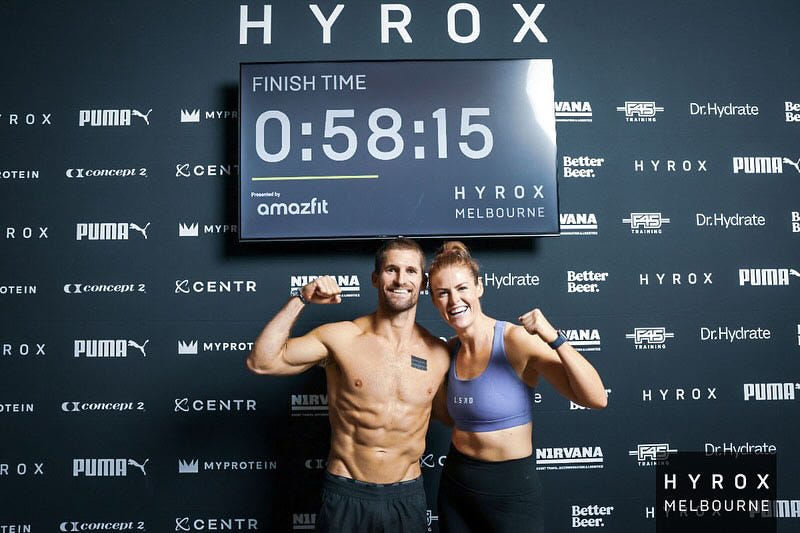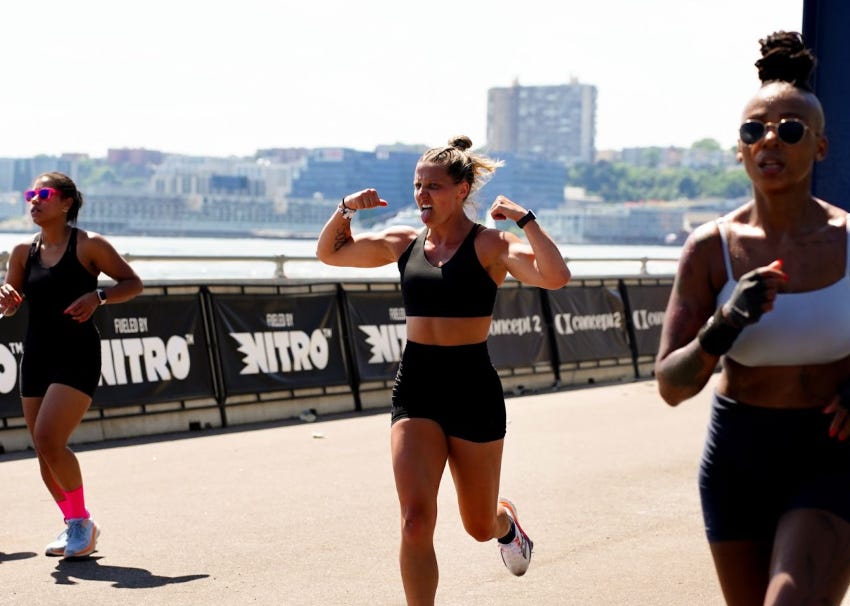The secrets of the SkiErg
Jane Erbacher, the founder of Erg Army, travels the world teaching people how to effectively use the row and ski ergs — two key elements of Hyrox races. She has coached top athletes, including 7-time CrossFit Games champion Tia-Clair Toomey-Orr and 2024 Hyrox Hong Kong champion Joanna Wietrzyk. Jane is an accomplished Hyrox athlete herself, qualifying for the 2024 Hyrox World Championship in Nice and finishing Hyrox Melbourne with partner Chris Wooley in 58:15.
Jane chatted with the Hybrid Letter about how she developed a love of ergs, her obsession with details, and her top cues for athletes.
This interview was edited for length and clarity.
The Hybrid Letter: Can you tell us a bit about yourself and what you do?
Jane Erbacher: My business is Erg Army, which is perfect because the first two letters of my last name are E-R. I don’t even go by my name anymore—my whole persona is Erg Army now. It’s almost like a superhero thing; I can be anybody as Erg Army, whereas Jane is a bit more shy.
I started Erg Army in 2017 in America. Before that, I was part of a group in Salt Lake City called Gym Jones, known for training actors for movies like 300 and various Marvel films, including Wonder Woman. They brought a yoga-like philosophy to high-intensity training, emphasizing that the mind is primary—your body will do what your mind tells it can or cannot do. I was really drawn to the idea that we’re capable of anything our mind allows.
While training there, I realized something I’d been thinking about for years—nobody in the fitness industry teaches the ergs properly. I had previously owned a gym in Melbourne and had worked in fitness since 2001. I’d been around for a long time but didn’t actually know how to use the equipment. At Gym Jones, we did a 2K test on the row and ski. To progress through certification, females had to complete it under eight minutes, and men under seven. I remember thinking, Brute strength will get me through the first 400 meters, but there are still 1,600 to go. That’s when I thought, Maybe I can become an expert at this. If no one else is doing it, why can’t I?
THL: How did you become an expert in the ergs?
JE: I spent a few years traveling around America, learning from rowing coaches and rowers. I even joined a high school rowing program in upstate New York and did their off-season training. I was working out with 15-year-olds and probably learning more than they were. I put myself in a complete beginner’s position and tried to absorb as much of the sport as possible. It took me five years to truly learn how to row.
Yet, in the fitness industry, people expect to learn it in 15 seconds. If a coach can’t explain it that quickly, people check out. The truth is, it takes about five years to master the complexities of the erg. That’s why I created something digestible—helping people improve in a way that makes sense in the fitness world rather than the rowing world. I focused on breaking down the technique into manageable elements so that fitness professionals and athletes alike could integrate proper rowing and skiing mechanics into their training without getting overwhelmed.
THL: How did the ski erg become part of that?
JE: I never set out to teach the ski erg. I was actually against it. But people kept asking, Can you teach us the ski erg? I thought, I don’t have two years to go and learn from Nordic skiers. Then I worked with a team and realized the way the ski erg was being used in fitness was completely different from how it’s used in Nordic skiing.
In Nordic skiing, you create a horizontal trajectory—you’re moving your center of mass forward. On the ski erg, it needs to be a vertical force to move the flywheel. Nordic skiers using a ski erg often need to be strapped in because their center of mass shifts forward so much—that’s how they train for their sport. When I started educating people on the ski erg, it was controversial because I approached it from a biomechanics perspective rather than Nordic skiing. It took me six years to prove myself, but evidence speaks for itself. Initially, I faced opposition, but now it’s just seen as an alternative—like a sumo deadlift versus a conventional deadlift. It’s a different but biomechanically sound approach.
THL: Why did coaches and gyms seek out your assistance?
JE: Before Hyrox, my business was already busy, but it was easier to sell to gyms than individual users. Gym owners wanted their members to move well, avoid injury, and actually enjoy training. Many people avoid the ergs—especially the ski erg—because they feel discomfort or frustration. If a gym had members dreading squat day because their backs hurt, they’d work on improving that. But with ergs, the attitude was, It’s just cardio—just get on and push through.
For the first few years, it was easy to connect with gym owners who wanted their members and coaches to improve. The challenge was reaching individuals. In America, there’s pressure to keep getting better—people are motivated. In Australia, we have the mindset of She’ll be right—settling for good rather than striving for great. So, selling to individuals was harder. In 2023, Hyrox changed everything. Suddenly, athletes were investing in shoes, outfits, travel, nutrition—this was their sport. That shift made selling to individual users much easier.
THL: What are some key coaching cues for the ski erg?
JE: Coaching the ski erg requires a structured approach. I focus first on the handle path, ensuring the handles move in a clean diagonal. Then, I guide athletes on setup, making sure they stand at a distance where their fingertips touch the frame and hold the handles in the fleshy part of their hands. From there, I emphasize static positions—the importance of a relaxed top position with engaged lats and triple extension, while the bottom position should be a hinge pattern rather than a squat.
Tempo is also a major component of proper ski erg technique. Athletes should move fast down and slow up, generating force efficiently rather than relying on brute strength. When all of these elements come together, the ski erg motion starts to feel more natural, improving both performance and endurance.
THL: What’s your strategy for the Hyrox 1,000m ski?
JE: A great example is Joanna Wietrzyk, who won the last major in Amsterdam. She was the only athlete to lower the damper—something I taught her. The preset settings are misleading, so I had her drop it to three. She lost a few seconds at first but gained them back with better energy efficiency.
At this point in the race, the goal is conserving energy while staying on pace. Attention to these details is just as crucial as the shoes you choose. Athletes should think strategically about every element of their performance, from damper settings to body mechanics. This awareness allows them to optimize efficiency, avoid unnecessary fatigue, and maximize their potential.
You can follow Jane on Instagram.
Interview of the Week: The business of Hyrox
If you are curious about the history of Hyrox and its business strategy, don't miss this interview with Hyrox co-founder Moritz Fürste.
Fun facts:
75% of Hyrox athletes buy the photo package after the race.
Hyrox starts making a profit on a one-day race after about 1500 people sign up. (Multi-day races are more profitable.)
Hyrox athletes send an average of $20 on merch at each race. Events in the United States sell the most merchandise.
The cheapest Hyrox event costs $200,000 to produce. Some, like New York, are much more expensive.
You can watch the whole interview here:
Hybrid Athlete of the Week: Kim Marra
Name: Kim Marra
Age: 30
Hometown: Sayville, NY
Why did you start hybrid racing? Well, I grew up my entire life playing sports of all kinds, even dancing for many years, so I’ve always done a little of everything. Soccer was always my main sport and overall passion, so I went on to play Division 1 soccer in college. I guess that’s when I got my first taste of hybrid training—building strength during weight sessions while also training as an endurance athlete on the field. “Hybrid athlete” wasn’t a term back then, but if I had to describe myself on the soccer field, I was both strong and fast. After college, I started working at Orangetheory Fitness, became a fitness coach, and continued to train as a hybrid-style athlete while also playing pre-professional soccer for six years. Since 2022, I’ve been coaching and training at OG Training, which is when I started racing in events like Hyrox. Training this way is just who I am—I love competing, and finding new environments for competition is what drives me.
Favorite race to date? Every race has special meaning because it’s a reflection of where I was in my training and in life at that moment. But as a competitor, I love to win, so my best race is my favorite. I raced Hyrox Chicago in the Women’s Pro division in November 2024 and placed second with a time of 1:10:30. Leading up to the race, I had that feeling that things were going to click—and they did. In my eyes, I ran my perfect race. That moment solidified for me that this was something I wanted to fully commit to and train even harder for.
Do you have a race goal? I never set an exact time goal, but my goal is always to do better than my last race. I train consistently, always trying to elevate my style of training, trust the hard work I put in, and show up ready on race day. I always say if you can confidently say you’ve done the work, race day should be the fun part! Regarding Hyrox, I got to compete at Worlds in France, and ideally, I’d love to qualify for Worlds every year—that’s the mission for 2025.
Favorite station? Probably an unpopular answer, but burpees. I’m really good at them! If you ask any members at my gym, they’ll tell you I do burpees every day for fun. In Hyrox, the early events are the toughest and most demanding, so by the time I get to burpees, which is the fourth event, it’s a good pick-me-up. That’s usually when I can really turn it up.
Least favorite station? Definitely the ski erg. I don’t think I’ll ever enjoy it, but I’m glad it’s the first event. I make sure to stay composed and pace myself so I don’t burn out too early, but the whole time, I’m just dreading it and wishing it were over.
Something you wish you knew when you started racing? I’ve been training my whole life, from sports to fitness to racing. I think my success comes from having an unwavering belief in myself—some might call it cockiness, but for me, it’s confidence in knowing I work hard 100% of the time. Anytime I feel off in my training, it’s usually because I haven’t been holding myself to my highest standard. One of the biggest lessons I’ve learned is the importance of surrounding yourself with people who are just as ambitious and willing to help you succeed. Whether that’s coaches, training partners, teammates, or just supporters of your dreams, having that kind of support system is key.



